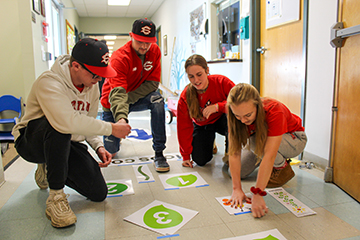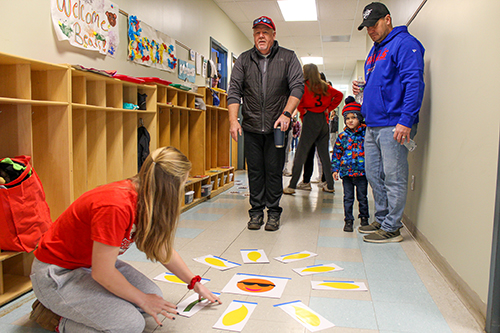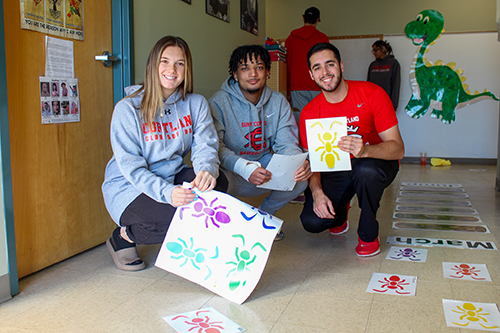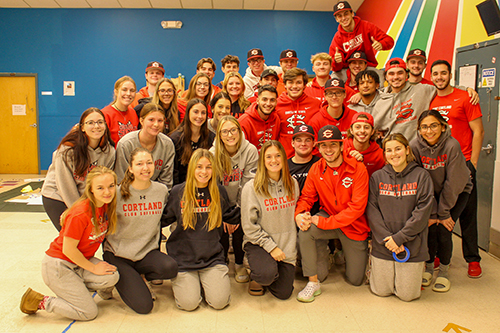
12/30/2022
Going to school and navigating to their preschool classrooms has new meaning for a select group of local children, thanks to a community service project that received a boost from SUNY Cortland’s Physical Education Department and student volunteers from two sport clubs.
Cortland’s Racker facility, which specializes in services for people with disabilities, recently added a large collection of colorful floor and wall stickers known as sensory pathways. The artwork encourages youngsters at Racker’s inclusive childcare center to practice important fundamental motor skills such as jumping, hopping, skipping and many others — during their daily school routines.
“After two-plus years of the pandemic, we’ve seen significant delays in children’s motor skills and social emotional skills ,” said Tim Davis, an associate professor of physical education at SUNY Cortland who has partnered with Racker for more than 20 years. “So the opportunity to move throughout the day is absolutely critical for child development.”
On the Saturday before finals week at SUNY Cortland, 34 members of the university’s baseball and softball sport club teams spent four hours installing the different sensory pathways created by Fit and Fun Playscapes, a small business based in Poughkeepsie, N.Y., that creates school supplies to aid physical and mental development.
The idea for the project was born this past summer, when Davis taught an inclusive activities class with a field experience at Racker. SUNY Cortland’s physical education students used vinyl rollout mats provided by Fit and Fun Playscapes for the first time.

“We put them out there and both the teachers and the kids responded incredibly well,” Davis said.
That led Brian Rozewski, director of preschool programs at Racker, to secure roughly $11,000 in grant funds for the project. Davis and Rozewski worked with Pam Gunther, the founder of Fit and Fun Playscapes, to map out more than a dozen age-appropriate sensory pathways that incorporated numbers, letters, animals and other kid-friendly graphics.
Examples included hopscotch games in the shape of flowers, a crab walk with graphics for hands and feet, marching instructions following a pattern of ants, a jumping path on wooden logs and many others.
Their installation would have taken much longer if not for the assistance of SUNY Cortland’s student volunteers. In addition to practicing and playing their respective sports, the university’s club baseball and softball teams often look for ways to build relationships off the field.
“Our teams were definitely happy to help out,” said Jared Rago, a junior physical education major from Holtsville, N.Y. “We always try to think about different things we can do outside of normal team activities. Not only were we volunteering and helping, but we were bonding as baseball and softball teams too.”
Both Rago and teammate Mike Greco were enrolled in Davis’ course built around a local effort called Project LEAPE, short for Leadership and Education in Adapted Physical Education. Victoria Kohler, president of the club softball team, is a physical education major too, so the team partnership was natural.

The Project LEAPE class encourages student participation in community programs while providing leadership opportunities for physical education majors. The impact of Project LEAPE has led to stronger community partnerships like the one at Racker.
“This just fit every piece,” Davis said. “I was thankful we had so many students because it would’ve taken days to put all of those stickers down.”
The installation process required students to watch tutorial videos and carefully consider how the adhesive sensory pathways were laid on the ground so that their positioning made sense for the motor abilities of preschoolers. Smoothing out the stickers also required teamwork and attention to detail.
Student volunteers represented many different academic majors in addition to physical education, such as childhood/early childhood education, psychology and sport management.
“We try to get everyone thinking about how preschoolers should move,” said Davis, noting that the recommended amount of physical activity for children is 60 minutes every day, according to the Centers for Disease Control and Prevention. “What I tell all of my students and community partners is that our goal is to help kids be more confident in their shoes, wherever they play.
“The way we get there is by practicing and playing.”

Davis also leads SUNY Cortland’s Sensory Integration/Motor Sensory Multi-Sensory Environment (SIMS/MSE) Lab, an interactive, cross-disciplinary play space in Park Center that serves the community and highlights the importance of adapted physical education for all children. He said there are many ways to incorporate sensory-based activities like the ones that the sticker pathways promote, from stencils traced on playground surfaces to rollout mats in gymnasiums.
“It’s no secret that movement helps cognitive learning,” Davis said. “And all of the literature says the more that we move, the better off we are — especially our brains and our own social emotional regulation.”
The sensory pathways project is just the latest example of collaboration between the university and Racker. Starting in 2023, three SUNY Cortland graduate students who are certified to teach physical education will teach it at the preschool level 20 hours each week in exchange for tuition credit at both the Cortland and Ithaca Racker centers.
“It’s just a strong connection between Cortland as a campus and a community partner,” Davis said. “Having that connection makes all the difference in the world.”